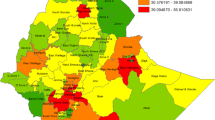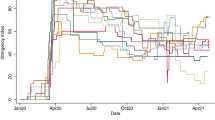Abstract
Objective:
To assess the internal validity of a multiple-item measure of household food security in Brazil using statistical methods based on the single-parameter logistic (Rasch) measurement model.
Subjects/Methods:
Sample of the non-institutionalized civilian population living in the municipality of Campinas selected using stratified cluster sampling. Of the 1000 households randomly chosen, 847 responded to the interview. Responses to each of the 15 questions were coded into dichotomous items indicating whether the specific food-insecure condition had occurred (other than in just 1 or 2 days) during the 3 months before the survey. Scaling analyses were conducted separately as well as jointly for adult/household-related items and child-related items. Item-fit statistics were examined to determine the extent to which the items appear to measure the same underlying phenomenon, and item severity scores were compared with those of equivalent items in the US Current Population Survey.
Results:
Except for one item, infit statistics were within a range considered adequate (0.80–1.2), indicating a common phenomenon being measured with approximately equal discrimination. The relative severites of the items in the Campinas survey were generally similar to those of equivalent items in the US Current Population Survey. Analysis of all 15 items together indicates a higher severity level for child-related items compared with equivalent adult-related items.
Conclusions:
This analysis will serve as the prototype for confirming the psychometric validity of a food insecurity scale at a national level.
This is a preview of subscription content, access via your institution
Access options
Subscribe to this journal
Receive 12 print issues and online access
$259.00 per year
only $21.58 per issue
Buy this article
- Purchase on Springer Link
- Instant access to full article PDF
Prices may be subject to local taxes which are calculated during checkout






Similar content being viewed by others
References
Alvarez MC, Montoya C, Estrada A, Melgar-Quiñonez H (2006). Validación de escala de percepción de la seguridad alimentaria doméstica en Antioquia, Colombia. Salud Publica Mex 48: 474– 481.
Bickel G, Nord M, Price C, Hamilton W, Cook J (2000). Guide to measuring household food security: Alexandria, VA US Department of Agriculture, Food and Nutrition Service.
Coates J, Frongillo EA, Rogers B, Webb P, Wilde PE, Houser RF (2004). Commonalities in the experience of household food insecurity across cultures: what are measures missing? J Nutr 136, 1438–1448.
Coates J, Frongillo EA, Rogers BL, Webb P, Wilde PE, Houser R et al. (2006). Comparison of a qualitative and a quantitative approach to developing a household food insecurity scale for Bangladesh. J Nutr 136, S1420–S1430.
Connell CL, Nord M, Lofton KL, Yadrick K (2004). Food security of older children can be assessed using a standardized survey instrument. J Nutr 134, S2566–S2572.
Derrickson JP, Fisher AG, Anderson JE (2000). The core US Food Security Survey Module scale measure is valid and reliable when used with Asians and Pacific Islanders. J Nutr 130, 2666–2674.
Frongillo EA (1999). Validation of measures of food insecurity and hunger. J Nutr 129, 506–509.
Frongillo EA, Chowdhury N, Ekstrom EC, Naved RT (2003). Understanding the experience of household food insecurity in rural Bangladesh leads to a measure different from that used in other countries. J Nutr 133, 4158–4162.
Frongillo EA, Nanama S (2006). Development and validation of an experience-based measure of household food insecurity within and across seasons in northern Burkina Faso. J Nutr 136, S1409–S1419.
Grosh M, Glewwe P (2000). Designing household survey questionnaires for developing countries: lessons from 15 years of the Living Standards Measurement Study Vols. 1, 2, and 3. Washington, DC: The World Bank.
Gulliford MC, Mahabir D, Nunes C, Rocke B (2005). Self-administration of a food security scale by adolescents: item functioning, socio-economic position and food intakes. J Public Health Nutr 8, S853–S860.
Gulliford MC, Mahabir D, Rocke B (2004). Reliability and validity of a short form household food security scale in a Caribbean community. BMC Public Health 16, S22.
Gulliford MC, Nunes C, Rocke B (2006). The 18 Household Food Security Survey items provide valid food security classifications for adults and children in the Caribbean. BMC Public Health 8, S26.
Instituto Brasileiro de Geografia e Estatística – IBGE (2004). Segurança Alimentar. Pesquisa Nacional por Amostra de Domicílios. Rio de Janeiro, 2006. Available at:http://www.ibge.gov.br/home/estatistica/populacao/trabalhoerendimento/pnad2004/suplalimentar2004/supl_alimentar2004.pdf.Accessed: 12 September 2006.
Johnson M, Melgar-Quinonez HR, Zubieta AC (2005). Food security and household food supplies in rural Ecuador. FASEB J 19, 595 3 (abstract).
Kaiser LL, Melgar-Quinonez H (2003). Food insecurity and food supplies in latino households with young children. J Nutr Educ Behav 35, 148–153.
Kaiser LL, Melgar-Quiñonez HR, Lamp CL, Johns MC, Sutherlin JM, Harwood JO (2002). Food security and nutritional outcomes of preschool-age Mexican–American children. J Am Diet Assoc 102, 924–929.
Lorenzana PA, Mercado C (2002). Measuring household food security in poor Venezuelan households. Public Health Nutr 5, 851–857.
Melgar-Quinonez H, Kaiser LL, Martin AC, Metz D, Olivares A (2003). Inseguridad alimentaria en Latinos de California: observaciones de grupos focales. Salud Publica Mex 45, 198–205.
Melgar-Quiñónez H, Zubieta AC, Valdez E, Whitelaw B, Kaiser L (2005). Validación de un instrumento para vigilar la inseguridad alimentaria en la Sierra de Manantlán, Jalisco. Salud Publica Mex 47, 413–422.
Melgar-Quinonez HR, Zubieta AC, MkNelly B, Nteziyaremye A, Gerardo MF, Dunford C (2006). Household Food insecurity and daily per capita food expenditure in Bolivia, Burkina Faso and the Philippines. J Nutr 136, 1431–1437.
Nord M, Bickel G (2002). Measuring children's food security in US households, 1995–99 Washington, DC Economic Research Service, US Department of Agriculture. Available at:www.ers.usda.gov/publications/fanrr25Accessed: 12 September 2006.
Nord M (2004). Food Security in the United States: History of the Food Security Measurement Project. Washington, DC Economic Research Service, US Department of Agriculture. Available at:http://www.ers.usda.gov/Briefing/FoodSecurity/history.htmAccessed: 23 August 2006.
Opsomer JD, Jensen HH, Pan S (2003). An evaluation of the US Department of Agriculture food security measure with generalized linear mixed models. J Nutr 133, S421–S427.
Parás P, Pérez-Escamilla R (2004). El rostro de la pobreza: la inseguridad alimentaria en el Distrito Federal. Revista Este País 158, 45–50.
Perez-Escamilla R, Segall-Correa AM, Kurdian Maranha L, Archanjo Sampaio MF, Marin-Leon L, Panigassi G (2004). An adapted version of the US Department of Agriculture food insecurity module is a valid tool for assessing household food insecurity in Campinas, Brazil. J Nutr 134, 1923–1928.
Projeto Fome Zero. Presented to the public by the Brazilian President Luis Inácio Lula da Silva in October 2001. Available at:http://www.rlc.fao.org/prior/segalim/fomezero/proyeng.pdfAccessed: 12 September, 2006.
Radimer KL, Olson CM, Campbell CC (1990). Development of indicators to assess hunger. J Nutr 120, 1544–1548.
Rose D (1999). Economic determinants and dietary consequences of food insecurity in the United States. J Nutr 129, 517–520.
Studdert LJ, Frongillo Jr EA, Valois P (2001). Household food insecurity was prevalent in Java during Indonesia's economic crisis. J Nutr 131, 2685–2691.
United Nation's Food and Agriculture Organization. Rome Declaration on World Food Security. World Food Summit, November 1996. Rome, Italy. Available at:http://www.fao.org/docrep/003/w3613e/w3613e00.htmAccessed: September 12, 2006.
Welch KJ, Mock N, Netrebenko O (1998). Measuring hunger in the Russian Federation using the Radimer/Cornell hunger scale. Bull World Health Organ 76, 143–148.
Wilde PE (2004). Differential response patterns affect food-security prevalence estimates for households with and without children. J Nutr 134, S1910–S1915.
Winsteps, Rasch Measurement version 3.52. Copyright© 2004 John M. Linacre. Chicago IL, USA.
Wolfe WS, Olson CM, Kendall A, Frongillo EA (1998). Hunger and food insecurity in the elderly – its nature and measurement. J Aging Health 10, 327–350.
Acknowledgements
This study was funded by Ministry of Health, Ministry of Social Development, FAPESP, OPAS and CNPq.
Author information
Authors and Affiliations
Corresponding author
Additional information
Contributors: HRM-Q led the data analysis, as well as the writing of the article; MN was senior analysis advisor in the Rasch modeling, giving major advice contributions to the interpretation of results; RP-E is a co-Principal Investigator in the validation research on the food security scale in Campinas, playing a major role in the discussion of the findings; AMS-C was the principal investigator in the food security scale validation study in Campinas, giving crucial advice in the interpretation of the results within the Brazilian context.
The views expressed in this article may not be attributed to the Economic Research Service or the US Department of Agriculture.
Rights and permissions
About this article
Cite this article
Melgar-Quinonez, H., Nord, M., Perez-Escamilla, R. et al. Psychometric properties of a modified US-household food security survey module in Campinas, Brazil. Eur J Clin Nutr 62, 665–673 (2008). https://doi.org/10.1038/sj.ejcn.1602760
Received:
Revised:
Accepted:
Published:
Issue Date:
DOI: https://doi.org/10.1038/sj.ejcn.1602760
Keywords
This article is cited by
-
Temporal Changes in the Association Between Food Insecurity and Socioeconomic Status in Two Population-Based Surveys in Rio de Janeiro, Brazil
Social Indicators Research (2019)
-
The Brazilian food security scale for indigenous Guarani households: Development and validation
Food Security (2018)
-
Internal validity of the Food Access Survey Tool in assessing household food insecurity in rural Zambia
Food Security (2016)
-
Validation of the food access survey tool to assess household food insecurity in rural Bangladesh
BMC Public Health (2015)
-
Household food insecurity in small municipalities in Northeastern Brazil: a validation study
Food Security (2012)



